In Memoriam, Frank Frazetta
Frank Frazetta recently passed away. You may not immediately recognize his name, but it is likely you have seen his artwork at least once in your life, especially if you recognize the name of the southern rock band "Molly Hatchet." Frazetta's artwork occupied a certain niche, where it was wildly popular. This niche is hard to define, as it actually ranges over a wide realm of what might be called the "Kingdom of Geekiness" -- science fiction, fantasy, and even (gasp!) comic books. Naturally, as a result, Frazetta was sneered at by the "real" art world. This matters not a whit to fans of his artwork, who are legion. As, indeed, it should not.
Here is the image which is, quite likely, the most-recognized work he ever did:
[Note: All images in this story are clickable links which lead to larger-sized images on external sites, for copyright reasons.]
The southern rock 1970s/80s band Molly Hatchet used this image on their first and eponymously-titled album. They later used other Frazetta paintings on subsequent albums, which, for many of their popular audience, was also an introduction to the artist's work. Echoes of the haunting red eyes in this image live on today, in "demon sheep" political ads in California, I hasten to point out.
Frazetta's work was mostly associated with the realm of fantasy -- starting with the fantasy books he would illustrate. Now, "fantasy" (in the literary arts world) is seen as some sort of bastard stepchild to "real" literature. It's usually lumped together with another of these somehow-illegitimate offspring -- the dreaded "science fiction" -- both of which (the literature mavens assure us) can be safely ignored by all proper literary arts connoisseurs. Or, at least, the publishing world used to heap such sneering derision on "fantasy"... at least until the Harry Potter books pretty much singlehandedly saved the publishing industry from a fatal slump.
Frazetta illustrated Edgar Rice Burroughs' work (his Tarzan series, and the "Barsoom" or "Mars" books), the Conan series, and other pre-historical fantasy worlds, often peopled with fierce weapons-wielding warriors, menacing monstrous animals, and (of course) scantily-clad women. Actually, truth be told, lots of scantily-clad (or completely unclad, for that matter) women. Which, even before his work started appearing on album covers, gained him lots of fans. In a certain audience, as it were. Not that there weren't scantily-clad males to go along with the scenes, as well.
But the genre of literature -- including even the lowly comic book itself -- which was Frazetta's customer base wasn't just looked down on by English majors in liberal arts colleges across the land (at least, until the release of the comic-tragic masterpiece Maus, by Art Spiegelman), Frazetta's artwork was also sneered at by the folks over in the Fine Arts building on that same liberal arts campus, as well. Because Frazetta's work wasn't what the art critics thought modern art should be, and they (to put it mildly) were not impressed. To epitomize this scorn, they called him their worst insult -- a mere illustrator, and definitely not an artiste, as they defined those terms.
To which I say: "Hogwash!" I would be blunter, but I simply cannot find the correct spelling for the sound a Bronx cheer (or, if you're from other regions, a "raspberry") makes, so I cannot fully express my feelings in the matter without some sort of multimedia sound file here. Ahem.
But it simply must be said -- just because the intelligentsia of the day does not deem your work to be sufficiently snobby so as to be classified worthy of the label "art" is an absolutely meaningless distinction. I will repeat that statement: meaningless. Because much of the disdain heaped upon mere "illustrators" is the crushing rage these cutting edge artists have for anyone who can actually sell their work and, indeed, make a living off of it -- assumably because people actually enjoy the work you have produced. Sometimes the insult is compounded by, instead of using the word "mere," saying instead "commercial illustrator." In other words, a successful artist.
This distinction is ridiculous when viewed through history's lens, in just about any field of arts. Charles Dickens wrote what we would call serialized novels. He published a few chapters each month in (say it softly) popular magazines, and then later sold out and cashed in by publishing the whole thing as a book. Today, he might be writing for a television soap opera. Edgar Allen Poe lived a life of poverty, and died virtually penniless (as did countless other writers and artists). Vincent Van Gogh never sold a single painting in his life, unless you want to count the one his brother Theo told him he had sold -- even though Theo himself had paid for it on the sly, just to cheer his brother up a bit. Salvador Dali and Pablo Picasso, however, always had a keen eye out for making a buck off their work, especially in their later years. It cannot be stressed enough -- such commercial success is neither a requirement nor an impediment to the value of an artist's actual work.
Of course, this doesn't mean that every artist who sells his work while alive but is sneered at by the art world will later be considered a genius. Nor does it mean every starving artist pushing the boundaries of what is considered "art" will, either. But it does mean that anyone who likes a certain artist for the art which they produce should be unashamed to say so, and should ignore what the art mavens and critics of the day think about that fact.
Some art speaks to some people. Not all art speaks to everyone. But, either way, it is no real measure of the artist themselves, because that is a very personal thing which even history's verdict cannot change.
Which brings me, in a roundabout way, to the case of Maxfield Parrish. Parrish was another artist who merely illustrated things, according to the critics of his day. His work started out geared towards children's books and calendar art, and was also in the realm of fantasy. Parrish's fantasies did run on a softer, and more "classical," line than Frazetta's, however. Parrish is most famous for his scenes of scantily-clad women painted surrounded by breathtaking lighting of one sort or another, or (at the very least) a breathtaking background behind them. Just as with Frazetta, even if you don't immediately recognize Parrish's name, you are just about guaranteed to immediately recognize at least two of his works:
There are likely more examples of Parrish's work which you have seen as well. This is no accident, because Parrish probably sold more reproductions of his work (as posters, prints, advertisements, calendars, etc.) than any American artist of the past century, and perhaps of any American artist of all time (although Norman Rockwell might contest that claim, admittedly).
Parrish's work, to put it mildly, was popular. Very popular. Which didn't sit well with the mavens of the world of fine art, at the time. Parrish had plenty of contemporaneous detractors, who absolutely sneered at his work -- for being insufficiently modern, and insufficiently cutting-edge. All the while, Parrish was painting more stuff, and selling it like hotcakes. His paintings were so unique, there wasn't even a "school" the critics could really place him within. Another way to put this is: Parrish was an astonishingly original artist, in his own his time period.
Today, Maxfield Parrish is a lot more respected in the art world. His paintings hang in actual museums, and the masses still haven't stopped loving his art, to this date. Critics speak much more reverently about his work now, then when it was created. Time changes perception in the art world, in a big way, sometimes.
These days, Parrish's use of light, shadow, and form (columns and vases in particular) is considered absolutely "iconic." His brilliant colors and spectacular mountainsides have gained more respect, as time has passed. So much so that he now has an actual color named after him -- "Maxfield Parrish Blue" (which, you have to admit, is pretty cool -- what other artist can you name with their own iconic and self-referential color, after all?). Here's the best example of this color I could find (I have to apologize, because Parrish's work doesn't reproduce very well online, as a rule, because it's a lot more nuanced than these images can show):
The closest you can come to describing Parrish's early work (he later kept to pure landscapes, without human figures to distract) is what he himself called it, in an interview from 1931 where he declared he was moving on from it: "I'm done with girls on rocks."
Now, I'm not equating Parrish and Frazetta as artists, here, merely trying to prove a point. Even though both of these talented men could be said to create their own artwork which could loosely be described under a similar genre ("fantasy" paintings), they were very different artists and dealt with very different subject matters in very different styles and philosophies. Parrish's work is bright and well-lit, Frazetta's is mostly pretty dark. Frazetta loved violence as a theme, Parrish reveled in sheer beauty. But when you compare sketches and drawings by the two, it's sometimes hard to tell who did what:
A key giveaway, of course, is that Frazetta like his women rather, um... well-endowed, shall we say; while Parrish (painting in the 1920s, when the flapper was the "It" girl of the day) was much more in tune with lithe nymph-like and downright sylvan girls, up to the point of androgyny, at times. The image on the left is Frazetta's, the one on the right is Parrish's.
But that's not to say Frazetta couldn't paint his own "girls on rocks" paintings, with his own particular take on the scene.
Or paint girls (more buxom than Parrish's, of course) next to interestingly-lit Greco-Roman columns...
Or, for that matter, master the Maxfield Parrish blue.
The differences between Frazetta and Parrish are as stark as those between Edgar Allen Poe (or Steven King, for that matter) and Ursula K. LeGuin, or Anne McCafferey. It's purity, sweetness, and light versus darkness, nightmare, and death.
But not everyone likes purity, and sweetness, just as not everyone's into images from the dark recesses of the soul. Different tastes are what make art interesting, to put it another way. And Frazetta was unquestionably the best at what he did, unless you care to make an argument for H.R. Giger (whom I consider to be in a slightly different genre, and so really not a true comparison at all), or perhaps Roger Dean (whom I consider to be in a class by himself, I should mention). Frazetta's fantasy paintings did indeed set the gold standard, for all who have followed in his footsteps. His use of color and his treatment of the human form is just as interesting in its own way as Parrish's. So I mourned the passing of a true artist when I heard of Frazetta's death, critics be damned. And I close with one of my favorite images from him, which showed his sense of humor as well as his mastery of both action and images of the female form -- "Queen Kong" -- just because it is so representative of his overall body of work, as well as because the image itself is such a joke upon the Kong mythos:
Requiescat In Pace, Frank Frazetta. You will be missed.
[Note: The offical site for Frank Frazetta's work seems to be down right now, as they are doubtlessly updating it to reflect the artist's death. Here is what seems to be one of the best unofficial sites dedicated to Frazetta's work, with a huge collection of his work. Maxfield Parrish's work can be found many places on the web, but this site has a good overview of some of his most well-known works.]
-- Chris Weigant
Follow Chris on Twitter: @ChrisWeigant

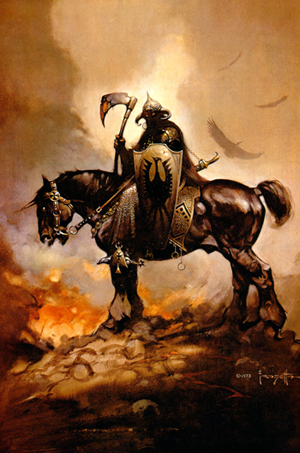
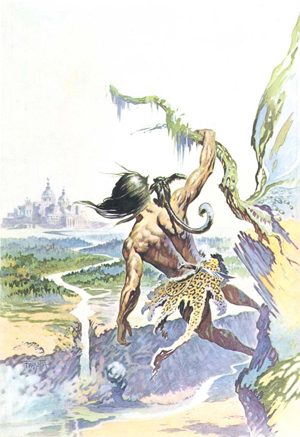
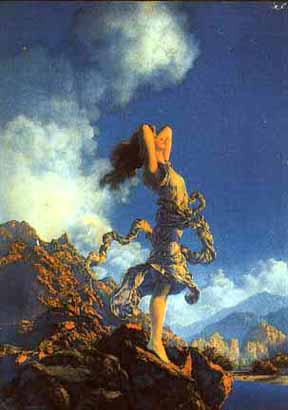
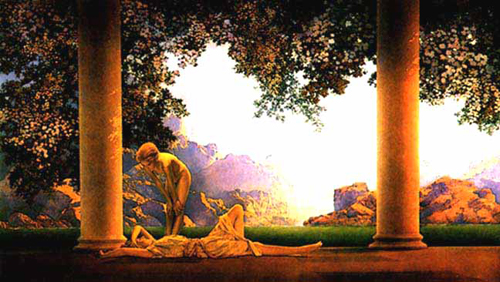
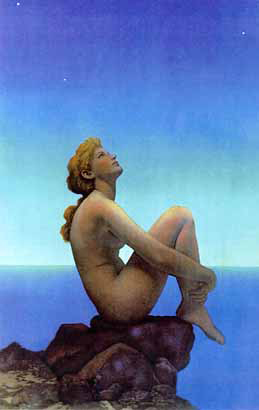
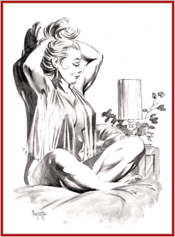
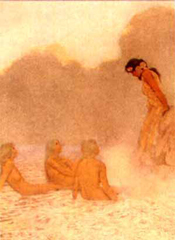
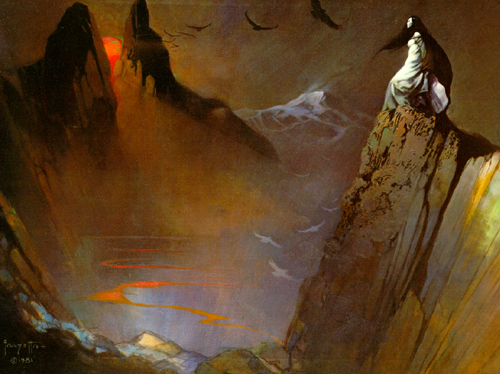
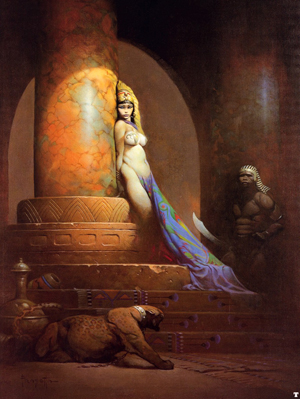
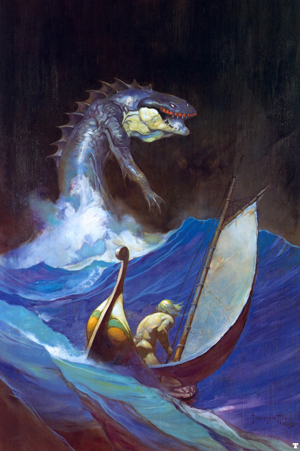
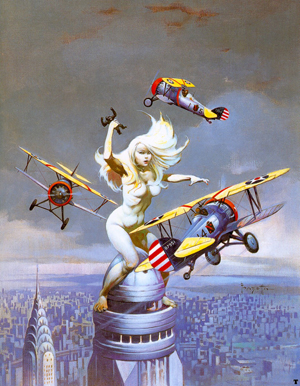





Another great one has passed beyond the veil and we are all poorer for it.
Michale....
Those images are absolutely stunning. Thanks for showing them here.
M, L -
Yeah, his passing saddened anyone who has ever seen more of his work than just what appeared on Molly Hatchet covers. His Barsoom paintings, in particular, are simply awesome. This was a good fit for his chosen style, since on ERB's Mars, everyone walked around naked pretty much all of the time, except for a few jewels (for Dejah Thoris and the rest of the Barsoomian women), or "fighting leathers" (whatever they were) for the men.
Anyway, this column was a labor of love, and I apologize that it got posted so late, but I was interrupted by external life on Tuesday for a while, and then it took a LOT longer to review Frazetta's work and decide which ones to pick (there are 28 pages of thumbnails on the site I cited). I heartily encourage everyone to visit this site, and see for yourself some of the spectacular paintings Frazetta created, as it is time well spent. Any fan of Conan, Tarzan, Barsoom, or even Slaine or Middle Earth who has not seen these works really needs to check them out.
-CW
This was a good fit for his chosen style, since on ERB's Mars, everyone walked around naked pretty much all of the time, except for a few jewels (for Dejah Thoris and the rest of the Barsoomian women), or "fighting leathers" (whatever they were) for the men.
I heard "naked"..... then what??? :D
Michale...
Chris,
That was a labour of love, indeed ... a fascinating piece! And, the site you cite is excellent, too. It's been added to my favourites for future reference.
Michale [4] -
OK, as penance for not answering comments for the past few weeks, I looked it up and typed it out for you. From "A Princess Of Mars" (Mars book #1), here is Captain John Carter, late of Virginia, describing seeing Dejah Thoris, Princess of fair Helium, for the first time:
"Her face was oval and beautiful in the extreme, her every feature was finely chisled and exquisite, her eyes large and lustrous and her head surmounted by a mass of coal black, waving hair, caught loosely in a strange yet becoming coiffure. Her skin was of a light reddish copper color, against which the crimson of her cheeks and the ruby of her beautifully molded lips shone with a strangely enhancing effect.
She was as destitute of clothes as the green Martians who accompanied her; indeed, save for her highly wrought ornaments she was entirely naked, nor could any apparel have enhanced the beauty of her perfect and symmetrical figure."
Burroughs was full of stuff like that -- well worth digging out of the used bookstore or library and checking out. Even if the copies you read don't have Frazetta on the cover. Heh. You can see how an artist like Frazetta would be drawn to such stuff, though.
-CW